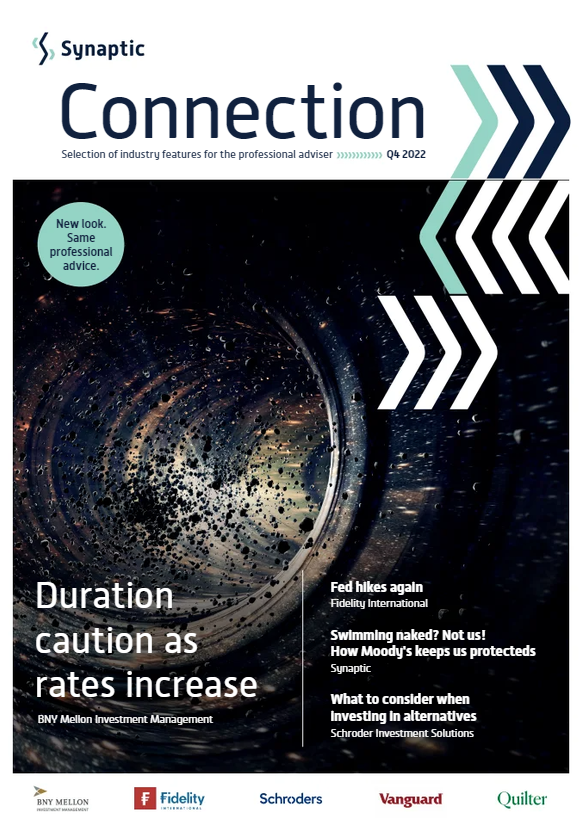In this edition...
- Ignore the Noise and Stick to the Strategy Eric Armstrong, Client Director, Synaptic
- Fed hikes again, but are we passed peak hawkishness? Salman Ahmed, Global Head of Macro and Strategic Asset Allocation, Fidelity International
- Duration caution as rates increase Paul Flood, Head of Mixed Assets Investment Newton Investment Management, part of BNY Mellon Investment Management
- Why investors shouldn’t overreact to talk of a recession Shaan Raithatha, Senior Economist - Vanguard, Europe
- What should I consider when investing in Alternatives in my multi-asset portfolio? Alex Funk, CIO Schroder, Investment Solutions
- Has the world changed? Mark Harris, Portfolio Manager, EPIC Investment Partners
- Swimming naked? Not us. Moody’s keeps us well protected. Eric Armstrong, Client Director, Synaptic
- The high-carbon transition Natasha Landell-Mills, Head of Stewardship, Sarasin & Partners
- Twitter, tech stocks & the untapped monetary potential Richard O’Sullivan, Investment Research Manager, RSMR
- GPUs are driving the future of computing Hamish Chamberlayne, Head of Global, Sustainable Equities
- Impact investing doesn’t mean compromising on returns M&G Investments,
- Quilter: Integrating responsible investment into your advice process Andy Miller, Investment Director Lead, Quilter
- Being green is in fashion Rahab Paracha, Sustainable multi-asset investment specialist, Rathbones
- Growth Investing: why the hunt for outliers remains compelling Stuart Dunbar, Partner, Baillie Gifford & Co
- Freedoms revisited - Where do we go from here? Matt Ward, Communications Director, AKG

Despite the Fed’s fourth straight jumbo rate hike, Global Head of Macro & Strategic Asset Allocation Salman Ahmed outlines why peak hawkishness from central banks is now likely behind us. He discusses how the economic outlook is set to evolve and the implications for returns across major asset classes.
What happened
As expected, the Fed hiked rates by 75 basis points at its November meeting, its fourth straight jumbo hike. It did however indicate an intention to slow down the pace of hikes, starting as early as its December meeting, to account for the lagged effects of accumulated tightening to date, which remain highly uncertain. To avoid the ‘pivot mania’ of last
summer, Chair Powell also indicated the possibility of a higher terminal rate - which we expect to be 5 per cent - and defended the ongoing policy stance robustly. In the press conference, Chair Powell defended the Fed's focus on mostly backwardlooking data, unwilling to concede that current price and labour market pressures are all essentially rearmirror dynamics.
Our interpretation
The Fed continues to send an unequivocally hawkish message, with no dovish pivot in sight. For the time being, fighting inflation remains the Fed's singular point of focus as the Federal Open Market Committee's risk assessment is skewed towards fear of doing too little, rather than doing too much (the latter - in contrast - being the key market worry). The bar for changing this stance remains high, with slowing economic data unlikely to be sufficient for a dovish pivot in the next few months.
"Our activity trackers indicate a 55 per cent chance of recession by mid-next year."
Outlook
We continue to expect a US recession in 2023 as the policy tightening cycle works through the system. Indeed, our activity trackers indicate a 55 per cent chance of recession by mid-next year. What is more uncertain is the potential depth and duration of that recession, which will depend on the ability of the economy to withstand tightening, the impact of external shocks, and the policy reaction to the downturn.
We continue to watch for any signs that the Fed is switching its focus from spot inflation data (backward-looking) to forward-looking indicators.
This would be the clearest indication of an imminent pivot, as some parts of the US economy, such as the housing market, are already showing signs of stress. If financial conditions tighten abruptly due to market-related stresses or financial stability concerns, we may well see a faster deceleration of the hiking pace and indeed a pause. But we are far from that right now and uncertainty remains very high given many moving parts. From a medium term perspective, we continue to think that a US 10-year real rate above 1 per cent is unsustainable but again it will take time for related damage to come through.
Asset allocation views
In the last few weeks, we reduced our underweight to duration to reflect the fact that peak hawkishness is probably behind us. We are still underweight equities and credit, as the worsening economic conditions have not fed through to earnings yet. Within equities, we remain overweight US vs Europe ex UK and within credit we prefer investment grade to high yield. Until the Fed pivot comes firmly into sight, we expect the dollar’s strength to continue - we remain overweight the dollar against a basket of emerging market currencies.
"From a medium term perspective, we continue to think that a US 10-year real rate above 1 per cent is unsustainable but again it will take time for related damage to come through."
For more information please contact Tim Mason, Sales Associate Director for Strategic Accounts:
Get in touch
Important Information:
This information is for investment professionals only and should not be relied upon by private investors. Past performance is not a reliable indicator of future returns. Investors should note that the views expressed may no longer be current and may have already been acted upon. Changes in currency exchange rates may affect the value of investments in overseas markets. The value of bonds is influenced by movements in interest rates and bond yields. If interest rates and so bond yields rise, bond prices tend to fall, and vice versa. The price of bonds with a longer lifetime until maturity is generally more sensitive to interest rate movements than those with a shorter lifetime to maturity. The risk of default is based on the issuers ability to make interest payments and to repay the loan at maturity. Default risk may therefore vary between government issuers as well as between different corporate issuers. Issued by Financial Administration Services Limited and FIL Pensions Management, authorised and regulated by the Financial Conduct Authority. Fidelity, Fidelity International, the Fidelity International logo and F symbol are trademarks of FIL Limited.
Sign up for updates
Keep up to speed with everything you need to know each quarter, by email or post.


